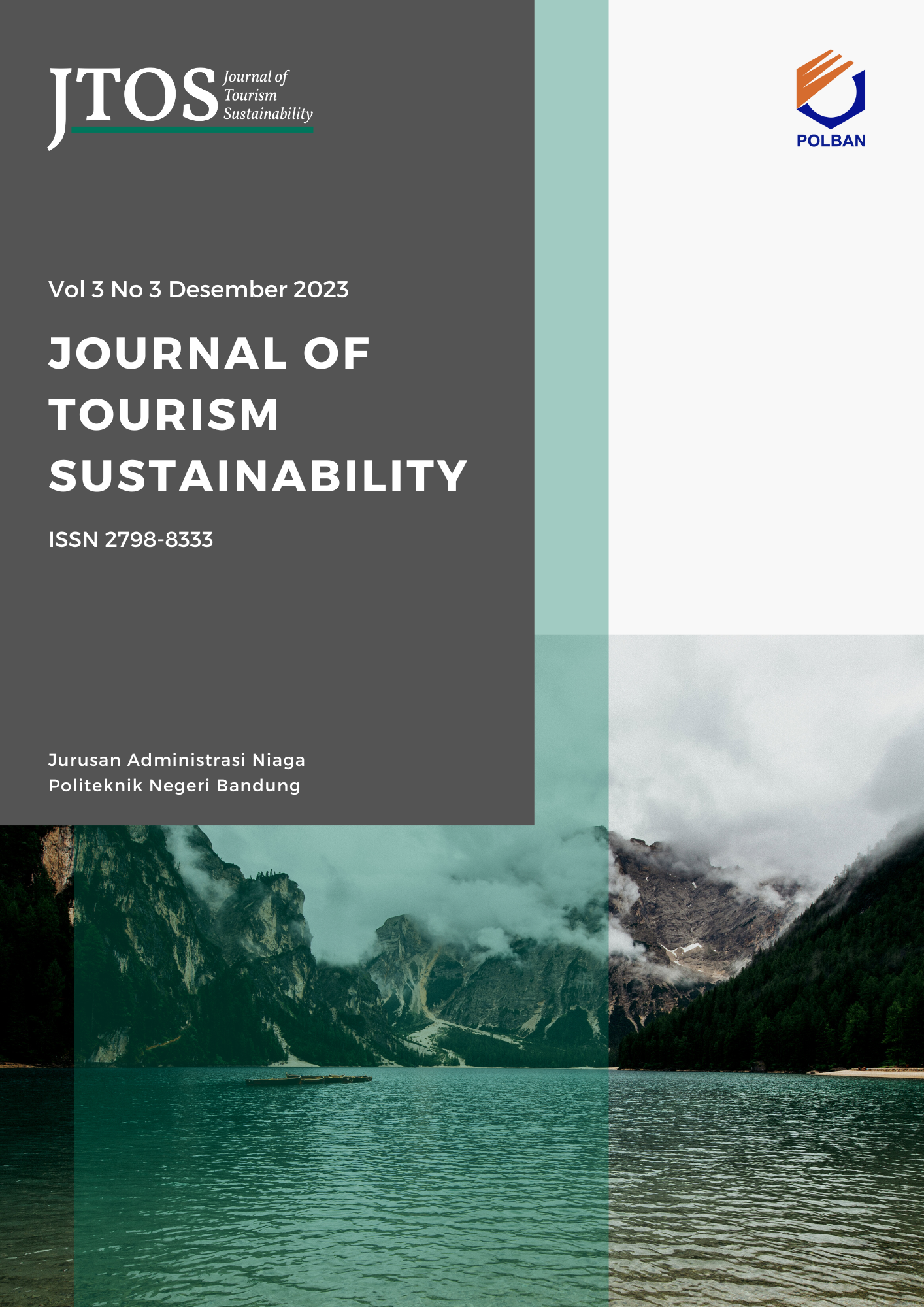Evaluation of Air Pollution in Terms of Sustainability: The Case (Example) of Izmir Carbon Footprint
DOI:
https://doi.org/10.35313/jtospolban.v5i4.180Keywords:
Carbon Footprint, Air Quality In Tourism, Turkey Air QualityAbstract
Air pollution is a global problem and significantly impacts every country. Therefore, this study aims to assess the future state of air pollution in Izmir. One of the key innovations of our study is demonstrating how PM (particulate matter) levels specifically influence tourists' destination choices. This study utilizes quantitative data analysis and preprocessing using the Pandas and NumPy libraries. The research methodology is based on data collected from the National Air Quality Monitoring Network. We evaluated the number of ships arriving at Izmir's port from 2008 to 2024 and created maps to visualize changes, including those during the COVID-19 period. Based on our findings, it can be concluded that annual CO (carbon monoxide) and NOX (nitrogen oxide) levels in Izmir are high and are significantly higher in industrial areas than in rural areas. The scenario analysis conducted in this research indicates that if air pollution continues to increase by 15%, air travel will be more severely affected than sea travel. Implementing effective waste management strategies in port cities is believed to benefit both the environment and public health. Practical implications: Key actions to combat air pollution include encouraging local travel habits, increasing the appeal of green transportation options, and raising environmental awareness. Green travel supports a more sustainable transportation system by reducing residents' environmental impact. In the future, informing travelers about ecological damage could lead to changes in travel behavior.
References
Agyeman, F. O., Zhiqiang, M., Li, M., Sampene, A. K., Dapaah, M. F., Kedjanyi, E. A. G., Buabeng, P., Li, Y., Hakro, S., & Heydari, M. (2022). Probing the effect of governance of tourism development, economic growth, and foreign direct investment on carbon dioxide emissions in Africa: The African experience. Energies, 15(13), 4530. https://doi.org/10.3390/en15134530
Aygül, Ö., & Baştuğ, S. (2020). Deniz taşımacılığı kaynaklı hava kirliliği ve insan sağlığına etkisi. Journal of Maritime Transport and Logistics, 1(1), 26–40. https://doi.org/10.46412/mtl.2020.725484
Campos, C., Laso, J., Cristóbal, J., Albertí, J., Bala, A., Fullana-i-Palmer, P., Margallo, M., & Aldaco, M. (2022). Towards more sustainable tourism under a carbon footprint approach: The Camino Lebaniego case study. Journal of Cleaner Production, 369, 133222. https://doi.org/10.1016/j.jclepro.2022.133222
Cengiz, B. (2023). IoT-based air quality measurement system (Master’s thesis, Sakarya University, Türkiye).
Chai, T., & Draxler, R. R. (2014). Root mean square error (RMSE) or mean absolute error (MAE)? – Arguments against avoiding RMSE in the literature. Geoscientific Model Development, 7(3), 1247–1250. https://doi.org/10.5194/gmd-7-1247-2014
Cho, H., & Lee, J. (2020). Does transportation size matter for competitiveness in the logistics industry? The cases of maritime and air transportation. The Asian Journal of Shipping and Logistics, 36, 202–211. https://doi.org/10.1016/j.ajsl.2020.03.001
Creswell, J. W. (2014). Qualitative inquiry and research design: Choosing among five approaches (3rd ed.). Siyasal Publishing.
Global Protocol for Community-Scale Greenhouse Gas Inventories. (2021). Greenhouse Gas Protocol. World Resources Institute. https://ghgprotocol.org
Govindan, K., Zhuang, Y., & Chen, G. (2022). Analysis of factors influencing residents' waste sorting behavior: A case study of Shanghai. Journal of Cleaner Production, 349, 131126. https://doi.org/10.1016/j.jclepro.2022.131126
Environmental Impact Assessment. (2023). İzin ve Denetim Genel Müdürlüğü. https://webdosya.csb.gov.tr/db/ced/icerikler/2023_bulten-raporu.pdf
Filimonau, V., Dickinson, J., Robbins, D., & Reddy, M. V. (2013). The role of "indirect" greenhouse gas emissions in tourism: Assessing the hidden carbon impact from a holiday package tour. Transportation Research Part A: Policy and Practice, 54, 78–91. https://doi.org/10.1016/j.tra.2013.07.005
IQAir. (2025). World’s most polluted countries. https://www.iqair.com/world-most-polluted-countries
Jiménez-Islas, D., del Río-Rama, M. D. L. C., Pérez-Romero, M. E., & Flores-Romero, M. B. (2025). The carbon footprint associated with air transport in three Mexican tourist destinations. Quality & Quantity. https://doi.org/10.1007/s11135-025-02093-y
Kitamura, Y., Ichisugi, Y., Karkour, S., & Itsubo, N. (2020). Carbon footprint evaluation based on tourist consumption toward sustainable tourism in Japan. Sustainability, 12(6), 2219. https://doi.org/10.3390/su12062219
Li, J., Feng, Z., Zhang, Z., Zhu, D., & Huang, Z. (2024). Evolution of green travel behaviour on dynamic social networks. Travel Behaviour and Society, 37, 100866. https://doi.org/10.1016/j.tbs.2024.100866
Liang, Y., Xia, Y., Ke, S., Wang, Y., Wen, Q., Zhang, J., Zheng, Y., & Zimmermann, R. (2023). AirFormer: Predicting nationwide air quality in China with transformers. Proceedings of the AAAI Conference on Artificial Intelligence, 37(12), 14329–14337. https://doi.org/10.1609/aaai.v37i12.26676
Lise, W., & Tol, R. S. J. (2002). Impact of climate on tourist demand. Climatic Change, 55(4), 429–449. https://doi.org/10.1023/A:1020728021446
Malkoç, E. (2024). Air quality impact of natural protected areas: A case study of Sarayiçi Tavuk Forest, Edirne, Türkiye. Turkish Journal of Forestry, 25(3), 333–339. https://doi.org/10.18182/tjf.1442373
Merriam, S. B. (2018). Qualitative research: A guide to design and implementation (3rd ed.). Nobel Akademik.
Miller, G., & Torres-Delgado, A. (2023). Measuring sustainable tourism: A state-of-the-art review of sustainable tourism indicators. Journal of Sustainable Tourism, 31(7), 1483–1496. https://doi.org/10.1080/09669582.2022.2123845
Ministry of Culture and Tourism. (2022). İklim Değişikliği ve Turizm İlişkileri. https://yigm.ktb.gov.tr
NASA. (2025). Carbon cycle and ecosystems. https://terra.nasa.gov
Nonthapot, S., Sihabutr, C., & Lean, H. H. (2024). The effects of air pollution on tourism in Thailand. GeoJournal of Tourism and Geosites, 53(2), 522–527. https://doi.org/10.30892/gtg.53215-1227
Olivadese, M., & Dindo, M. L. (2023). Edible insects: A historical and cultural perspective on entomophagy with a focus on western societies. Insects, 14(8), 670. https://doi.org/10.3390/insects14080690
Peng, T., Chen, J., Wang, C., & Cao, Y. (2021). A forecast model of tourism demand driven by social network data. IEEE Access, 9, 109488–109496. https://doi.org/10.1109/ACCESS.2021.3102481
Prana Air. (2025). What is Air Quality Index (AQI) and its calculation? https://www.pranaair.com/blog/what-is-air-quality-index-aqi-and-its-calculation/
Periodic Table. (2025). Element 102: Nobelium. https://periodic-table.rsc.org/element/102/nobelium
Republic of Turkey Ministry of Environment, Urbanization and Climate Change. (2025). https://egethm.csb.gov.tr
Republic of Turkey Ministry of Environment, Urbanization and Climate Change. (2025a). Air quality parameters. https://sim.csb.gov.tr
Republic of Turkey Ministry of Environment, Urbanization and Climate Change. (2025b). Ozone information platform. https://ozonturkiye.csb.gov.tr
The Ministry of Health of Türkiye. (2022). Health Statistics Yearbook. https://dosyasb.saglik.gov.tr
Sun, J., Zhang, J. H., Wang, C., Duan, X., & Wang, Y. (2019). Escape or stay? Effects of haze pollution on domestic travel: Comparative analysis of different regions in China. Science of the Total Environment, 690, 151–157. https://doi.org/10.1016/j.scitotenv.2019.06.415
Sun, Y. Y., Cadarso, M. A., & Driml, S. (2020). Tourism carbon footprint inventories: A review of the environmentally extended input-output approach. Annals of Tourism Research, 82, 102928. https://doi.org/10.1016/j.annals.2020.102928
Ulutaş, K., Abujayyab, S. K. M., & Abu Amr, S. S. (2021). Evaluation of the major air pollutants levels and its interactions with meteorological parameters in Ankara. Journal of Engineering Sciences and Design, 9(4), 1284–1295. https://doi.org/10.21923/jesd.939724
Wang, L.-J., & Chen, M.-H. (2020). Nonlinear impact of air quality on tourist arrivals: New proposal and evidence. Journal of Travel Research, 60(2), 434–445. https://doi.org/10.1177/0047287519899993
Wang, Q., & Liu, S. (2023). The effects and pathogenesis of PM2.5 and its components on chronic obstructive pulmonary disease. International Journal of Chronic Obstructive Pulmonary Disease, 18, 493–506. https://doi.org/10.2147/COPD.S402122
World Health Organization. (2025). Air pollution data portal. https://www.who.int/data/gho/data/themes/air-pollution
World Health Organization. (2021). Global air quality guidelines. https://iris.who.int/handle/10665/345329
Wu, M. Y., Pearce, P. L., & Li, Q. (2018). Chinese behind the wheel: Factors affecting their satisfaction with international self-drive holidays. Journal of Destination Marketing & Management, 9, 12–19. https://doi.org/10.1016/j.jdmm.2017.09.004
Xiao, Y., Qiang, W. W., Chan, C. S., Yim, S. H., & Lee, H. F. (2024). How far can air pollution affect tourism in China? Evidence from panel unconditional quantile regressions. PLOS ONE, 19(6), e0304315. https://doi.org/10.1371/journal.pone.0304315
Viana, M., Hammingh, P., Colette, A., Querol, X., Degraeuwe, B., van Aardenne, J., & de Vlieger, I. (2014). Impact of maritime transport emissions on coastal air quality in Europe. Atmospheric Environment, 90, 96–105. https://doi.org/10.1016/j.atmosenv.2014.03.046
Zeydan, Ö. (2021). 2019 yılında Türkiye’deki partikül madde (PM10) kirliliğinin değerlendirilmesi. Iğdır Üniversitesi Fen Bilimleri Enstitüsü Dergisi, 11(1), 106–118. https://dergipark.org.tr/en/download/article-file/1127035
Zhang, Z., Zhang, S., Chen, C., & Yuan, J. (2024). A systematic survey of air quality prediction based on deep learning. Alexandria Engineering Journal, 93, 128–141. https://doi.org/10.1016/j.aej.2024.03.031
Downloads
Published
Issue
Section
License
Copyright (c) 2025 Ülker Çolakoğlu, Ceyda Işik, Armağan Aydın

This work is licensed under a Creative Commons Attribution-NonCommercial-ShareAlike 4.0 International License.



.png)

















